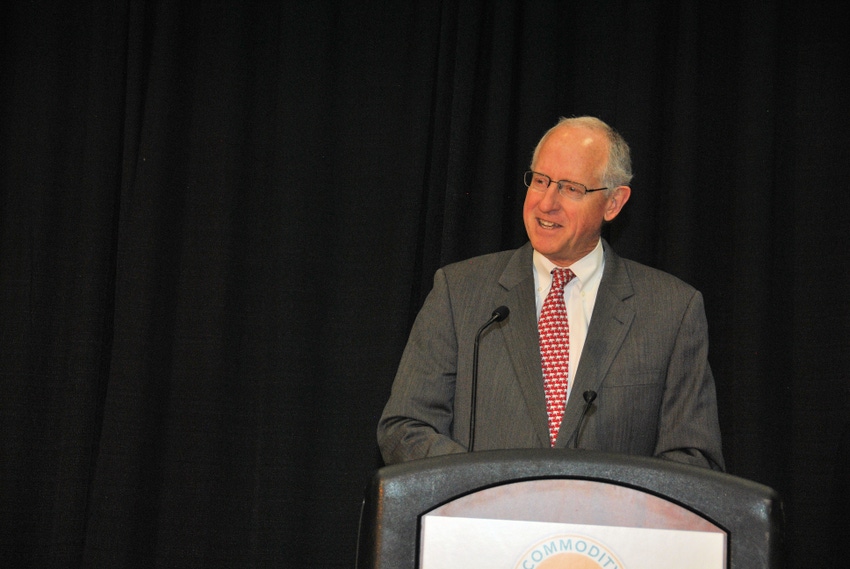March 3, 2017

It’s time for another farm bill to be born. Interest groups of all flavors are actively gathering the stats, pacts, opinions and facts they will swing to mold into life a complicated, regionally contentious piece of legislation.
The unfortunate truth is U.S. citizens by in large don’t care what the next farm bill looks like. They don’t care whether it smells like an elephant or kicks like a donkey or speaks with a Midwestern accent or a Southern drawl.
People who like to eat well affordably should rally the loudest to get the next farm bill well done and on time. Unfortunately, most U.S. citizens who eat don’t realize the deal they are getting as a direct result of a farm bill that is bolstered with a strong safety net for agriculture. That’s the farm bill’s challenge, though, one it’s carried for a long time, right? That was the bug Mike Conaway put in the ears of those attending the keynote address during the general session at the 2017 Commodity Classic in San Antonio March 3.
He put forth a titillating, poignant question that should, in theory, pull the ears of the farm bill interested and should-be-interested alike: “What will the next farm bill do to the price of food?”
The chairman of the House Committee on Agriculture said that question will drive how he steers the negotiations for the next farm bill.
Conaway threw a stat at the crowd: The top 20 percent of the economic strata in our country spends more money on food than the bottom 20 percent of our economic strata has in total disposable income.
With the next farm bill, he said the group at the bottom of the strata will who he thinks about “because they currently enjoy the most affordable food supply of any developed country and I’m not going to screw that up. As we look at changes to the next farm bill, I’m going to ask myself, ‘What does it do to the cost of food? What does it do to the single mom living paycheck to paycheck and maybe not on food stamps struggling to make ends meet?”
That’s the sort of question that’ll stir the nest or capture the attention of a wider audience, or both – in theory. The country’s farming sector and its citizenry’s access to an affordably safe food supply are joined at the stomachs and bank accounts in a lot of ways and a farm bill, in many ways, bonds them together for good and bad.
But that’s the challenge, right? How to drive that message without making someone hurt in either the wallet or the gut or, more the likely, in both places at once.
Conaway said the backdrop for why the nation needs a farm bill with a strong safety for farmers is going to be a little easier to explain in 2018 than it was in 2014 when the latest bill was written to the tune of high commodity prices, staunch farm profits and to the catcalls of special interest groups slamming such wasteful use of taxpayers funds for an industry obviously facing pleasantly flush times. Things change quickly in ag, and soon after the 2014 farm bill passed the U.S. ag economy was certainly going the way of things that get flushed.
The ag committee has conducted a two-year study on the state of the SNAP program which is tied to the farm bill and where that program should go. And those who champion SNAP will have a seat at the table for the next farm bill. So will the ones who want to reform welfare. The policy groups for corn, soybean, wheat and sorghum were meeting in San Antonio during Commodity Classic to continue their conversations on how the next farm bill can best serve their commodities. State, regional and other national farm groups are doing the same.
Conaway said he intends to drive forward with a timely farm bill for commodities and bulldoze through in roadblocks that could lead to stalemates and a patchwork of short-term extension. He wants SNAP side done on time, too. “But if the path forward makes it easier to get them (farm program and SNAP) done together, we’ll do it together. If it’s easier to get it done separately, we’ll do them separately. But I want to get them both done on time. … But the only people I’ve heard from who want to separate the farm bill from the SNAP are those who want to kill the farm program. I am spectacularly opposed to that.”
Conaway said the next farm bill will likely look and act a lot like the 2014 bill, but hopefully better-polished. At best, the funding base for the next bill will be at the level of the 2014 bill, which is on track to come under budget for its SNAP and farm programs. He did stress again during his comments to the non-cotton Commodity Classic general session, and during a press conference afterwards, that he wants to get cotton back in the farm bill as a program-covered crop in some shape or fashion.
You May Also Like




